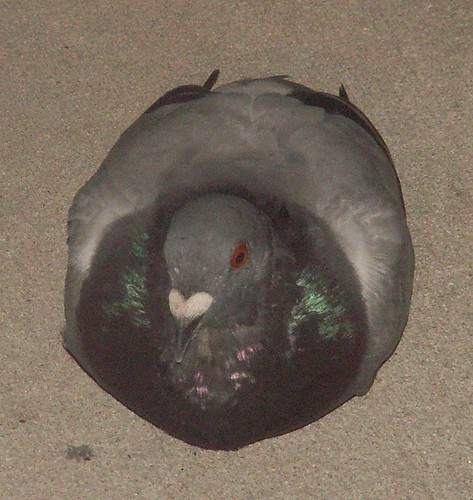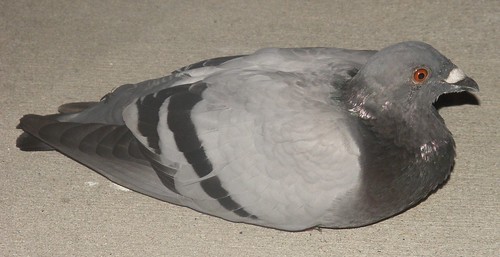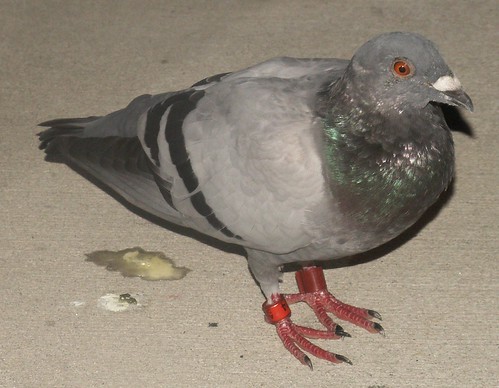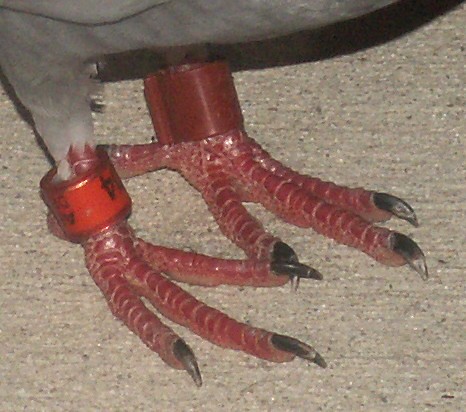Homing In

Mary and I had just left the supermarket when we spotted a pigeon sitting calmly outside the door to Cellular Revolution. The sight struck me for two reasons. One, because the pigeon didn't move at our approach -- and two, because in our 3-1/2 plus years here, we have not once seen a pigeon in this town until now....
At first I thought it might be sick. I'm not used to pigeons staying put at the approach of a human being. I was ready to simply leave it alone and walk off.
"I can think of a good reason to take a picture of it," Mary said.
"What's that?"
"West Nile."
She had a point. If we were looking at a sick bird, then county animal control should know about it: what, where, and when. I got out my camera and snapped a few shots, using a flashlight to provide enough illumination so that I could focus.

The pigeon stood and left a deposit on the cement walk.

Mary said, "It's banded."
Sure enough.
I sidled a little closer, took a few more shots.

Mary said, "I'm going to get it some whole wheat bread. It might be hungry."
I debated going to the store with her but then decided to keep the bird company. If anyone came along to bully it I was ready to run interference.
It had been raining. We were underneath an awning, standing on dry ground. Maybe the pigeon was taking a break after flying through inclement weather.
The bird and I pretty much kept an eye on each other. In my head I named it Walter, because I think of all such birds as Walter Pigeon. I wondered whom it belonged to. I wondered whether its owner worried about it and was wondering where it was, even though it was probably a homing pigeon and should know its way around. I wondered if it was on a special diet and shouldn't eat whole wheat bread. My mind played a recording of Tom Lehrer's "Poisoning Pigeons in the Park."
Mary returned with the newly-bought loaf of whole wheat bread. "I remembered what else we had to get," she said, holding up the bag. "Eggs."
Walter flapped a couple of steps away when she squatted down to leave a slice. She ultimately left two slices, the second one further away from the parking lot. Walter spent some time inspecting his/her reflection in Cellular Revolution's door, then faced us again. The bread remained untouched. We took off for home.
"Maybe I should have crumbled it," Mary said.
I told her I'd often seen pigeons clustered around full slices of bread on the sidewalk, picking it to pieces. But those were the non-banded kind. Untrained and unmannerly.
She added, "Maybe it isn't hungry. Or it eats only back at the cote."
I nodded. I liked the idea of pigeons being trained not to accept food from strangers. Plus, this one probably smelled our cats on us.

"Steve Ferreria, a Hillsborough County sheriff's deputy, wasn't even a teenager when he got hooked on homing pigeons," writes Jackie Ripley in the St. Petersburg Times article, "Thoroughbred Fliers." "That early infatuation has blossomed into a lifelong love affair and a place among Tampa Bay's subculture of pigeon fliers."
Ripley continues, "To some, pigeons are little more than nuisance birds. But that's far from the truth for homing pigeons, which bear only a passing resemblance to their urban cousins, forced to scrounge for their daily bread. Racers have been bred for speed. Their feathers are silkier and their breasts more bulging than regular street pigeons. They're also smarter and hardier than the typical street pigeon. These are pampered animals that routinely get vaccinations, vitamins and tender, loving care."
Judging from a read of Ripley's article dated December 4, 2005, "Walter" is a young pigeon taking a breather in the middle of a race. Young because September to December marks the "young bird" series of races. That would make "Walter" less than a year old, participating in a race covering no more than 300 miles and flying about 50 miles an hour in a competitive field of 2,000 birds. In addition to racing each other, the birds are up against hazards and predators ranging from power transmission lines to hawks. Given the risks of the race, their owners don't name them.
Ripley writes, "Pasco and Hernando counties, though, are the area's hot spots for pigeon activity. Fliers are drawn there by the weather and the competition. In fact, Spring Hill is home to at least 50 owners of some of the nation's most competitive birds."
According to Mapquest, Spring Hill is 30 miles away from us in the next county over, a straight shot south as the pigeon flies. I like to think we may have had a budding avian celebrity in our midst. One resting, perhaps, but still very much in the race.
Straight on till or before morning, Walter.











2 Comments:
Fascinating, really, how we come to be where we are and if we're taking a break in the race or are lost or injured. And now I'll be thinking about pidgeons all day! I hope the little critter's okay... that slice of whole wheat bread very sweet!
The angle of the first shot is intriging. I thought it was like one of my friend Jayn's pottery bowls! I love the name Walter Pigeon. On of my uncles kept pidgeons.
Post a Comment
<< Home